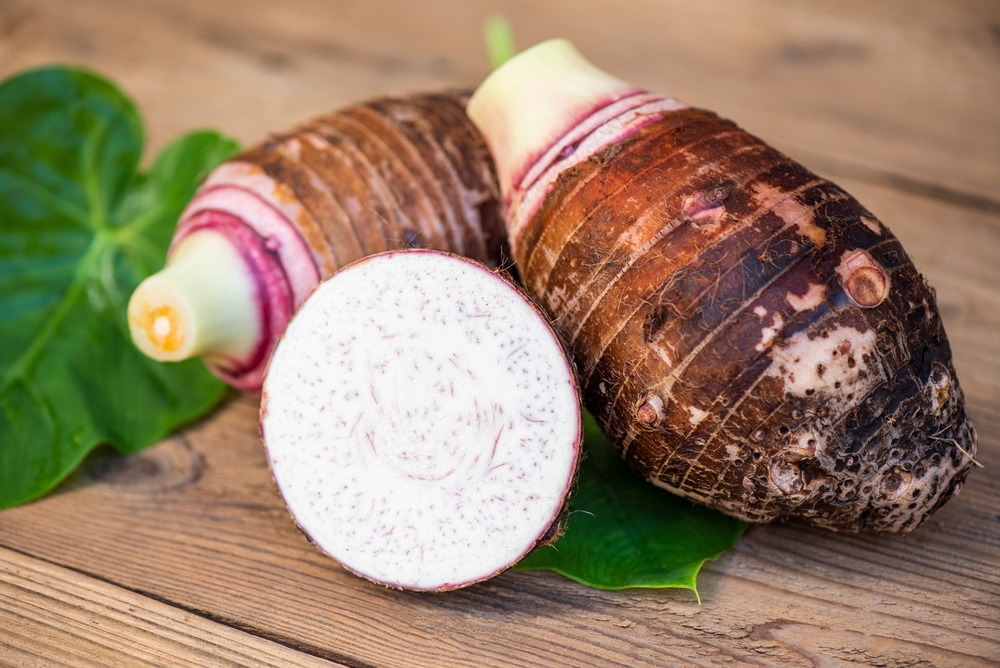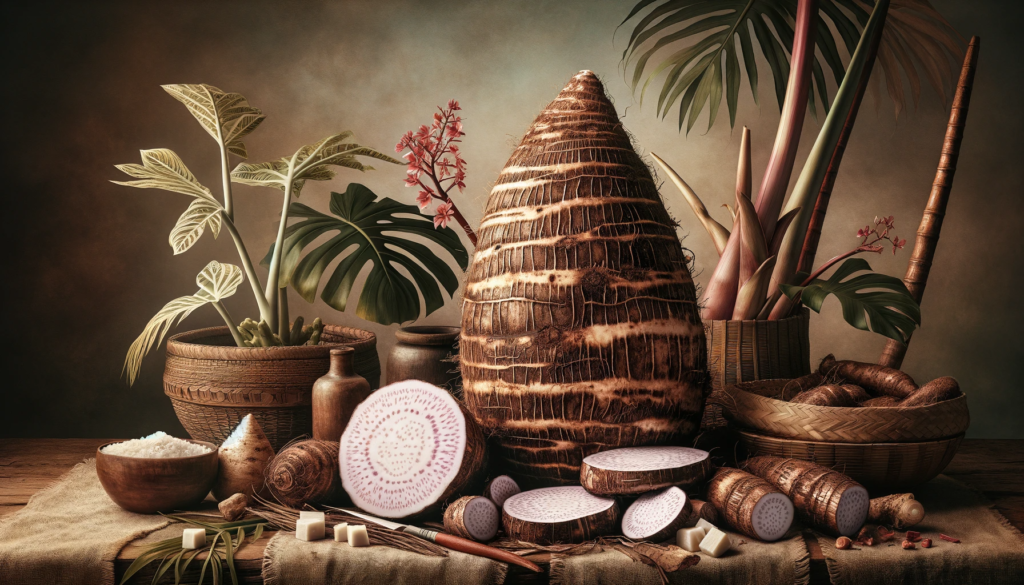Introduction to Taro Root in Pacific Cuisine
Understanding the Prominence of Taro Root in Pacific Island Cultures
Taro root holds a place of honor in the diets and cultures of the Pacific Islands, where it’s more than just a food source; it’s a cultural icon. Conveying respect and connectedness to the land, taro cultivation is integral to the social fabric of these islands. From a culinary perspective, taro is versatile, sustaining, and deeply ingrained in the traditions of the local people. Taro roots and leaves form the backbone of numerous Pacific Islander dishes, which are passed down through generations. This deep-rooted culinary staple represents the endurance and resilience of the Pacific cultures, where its preparation and consumption are surrounded by rituals and stories that exemplify the community’s way of life and ancestry.
The Cultural Significance of Taro Root
Taro’s Historical Importance and Symbolic Meaning in the Pacific
The significance of taro to Pacific Islanders stretches beyond its role as sustenance. Historically linked to the very creation stories of several islands, such as Hawaii, it embodies the cyclical relationship between man and earth. Symbolically, taro is often treated as an elder family member, with specific cultivars holding distinct stories and attributes attributed to ancestors. It is common for festivals, ceremonies, and communal gatherings to spotlight taro, helping maintain the social and spiritual connectivity within communities. Thus, taro root is vital for nutrition and serves as a cornerstone of Pacific cultural identity and communal harmony.

Nutritional Benefits of Taro Root
Health Advantages and Dietary Importance of Taro
Taro root is not only culturally significant but also nutritionally formidable. Packed with dietary fiber, it promotes digestive health and has a low glycemic index, making it suitable for weight management and diabetes control. Rich in essential vitamins and minerals like vitamin E, C, B6, magnesium, and iron, it contributes to immune system strength and red blood cell production. Its high level of antioxidants helps fight free radicals, which can lead to chronic diseases. Consuming taro can bolster heart health, thanks to its potassium content, which regulates blood pressure. This combination of nutrients makes taro an integral part of a balanced diet within Pacific Island communities and beyond.
Culinary Uses of Taro Root in Pacific Cooking
Traditional and Modern Ways to Prepare and Enjoy Taro
Taro root boasts diverse culinary applications in Pacific cooking, traditionally prepared through methods such as baking, boiling, and steaming. It’s a primary ingredient in poi, a Hawaiian delicacy made by mashing cooked taro until it reaches a smooth, sticky consistency. Contemporary Pacific cuisine has expanded taro’s applications, incorporating it into health-conscious diets as taro smoothies, chips, and gluten-free baked goods. Chefs explore the fusion of traditional and modern by integrating taro in innovative ways, while still respecting its cultural significance. Taro’s application in both traditional and avant-garde dishes demonstrates its adaptability and enduring relevance in Pacific Island diets.
Popular Taro-Based Dishes Across the Pacific Islands
In the diverse culinary landscape of the Pacific, taro-based dishes are both widespread and beloved. In Samoa, taro is a star in ‘fa’ausi,’ where it’s accompanied by coconut caramel sauce. The Hawaiian ‘laulau,’ entails pork and fish wrapped in taro leaves and slow-cooked to perfection. Similarly, Fiji’s ‘dalo’ is a commonplace side, often served with a tangy tamarind sauce. These regional specialties are not just about taste; they represent the common thread of taro in Pacific Island cuisine, showcasing its adaptability in complementing various proteins and flavors while remaining a nutritious diet staple.
Growing and Harvesting Taro Root
Agricultural Practices and the Significance of Taro Cultivation
Effective cultivation of taro is a testament to the agricultural knowledge of Pacific Islanders. Characteristically grown in ‘lo’i’ or paddy fields, taro thrives in wetland areas where the water-flow can be controlled. Farmers immerse the young plants in water, creating an ecosystem that sustains both the crop and the community. The harvest period is marked by a sophisticated understanding of the plant’s maturity signs. This deep-rooted agricultural practice is an emblem of sustainability and reflects the respect for nature inherent in Pacific cultures. Thus, taro cultivation goes beyond mere farming; it forges ecological awareness and cultural continuity.

Taro Root in Contemporary Pacific Cuisine
Innovative Culinary Creations and Fusion Dishes Involving Taro
As Pacific Island cuisines continue to evolve, taro remains central, but the form in which it appears is ever-changing. Innovative chefs leverage its versatility, curating dishes that speak to a modern palate while mirroring traditional flavors. Taro is reimagined in vegan recipes, deconstructed dishes, and global food fusions, retaining its nutritional benefits and cultural essence. For instance, taro buns and taro pancakes infuse distinct Pacific tastes into universally loved dishes. This culinary innovation paves the way for the beloved root to maintain its place at the table of contemporary Pacific communities, elevating its stature on a global gastronomic stage.
Preserving Taro Traditions and Embracing New Trends
The Balance Between Maintaining Tradition and Exploring New Flavors
While the culinary scene evolves, there is an undying effort to preserve taro traditions amidst the experimentation. Pacific Islanders seek a balance, cherishing ancient recipes that have traveled through time while welcoming new interpretations and flavors. This harmonious blend of the old and the new ensures that taro remains relevant, as the younger generations learn the significance of this staple through contemporary renditions of classic dishes. This respect for the root’s legacy in tandem with culinary creativity results in a rich and dynamic food culture that honors its past while confidently striding into the future.
FAQs About Taro Root in Pacific Island Cooking
How Do You Properly Peel and Cut Taro?
Handling the root with care is essential to safely peel and cut taro due to its calcium oxalate content, which can cause skin irritation. Start by wearing gloves and using a sharp knife. Cut off the ends of the taro root and make a lengthwise slit in the skin. Using your fingers or a paring knife, peel away the skin from top to bottom. Once peeled, slice or cube the taro root as desired for your recipe. Remember to cook taro thoroughly, as the cooking process eliminates the irritants and softens the root for consumption.
What Flavors Pair Well with Taro?
Taro’s mild, nutty flavor pairs well with a variety of ingredients. Coconut milk accentuates its subtle sweetness, while savory components like soy sauce or seaweed amplify its earthiness. Cinnamon, nutmeg, and vanilla are used nicely in sweeter taro dishes. Pairing taro with garlic, ginger, or green onions can enhance its taste in savory meals. Combine taro with protein sources like pork, chicken, or fish to create hearty meals that are commonplace in Pacific Island cuisine.
How Can You Achieve the Right Texture When Cooking Taro?
To achieve the desired texture in taro dishes, consider the end result you’re targeting. For a soft, smooth texture as in poi or taro purée, cook peeled taro in boiling water until it’s very tender, which can take about 45 minutes. If you’re making taro chips or fries, slice the root thinly and deep-fry or bake until it’s crispy. Steaming taro for 20 to 30 minutes will provide you with a firm yet tender consistency, perfect for salads or adding to stews. Monitoring and adjusting cooking times based on the size and cut of your taro pieces will help you reach the right texture for your culinary creation.
What Are the Best Cooking Methods for Taro?
The best cooking methods for taro depend on the dish you’re preparing. Boiling is common for mashes and purees, while baking is suitable for preparing taro whole, especially when stuffed or seasoned. For crispy snacks like taro chips, frying or air-frying slices will deliver crunchy results. In soups and stews, diced taro can be simmered until tender. Steaming is another excellent method that preserves the root’s flavor and nutrients, making it ideal for lighter meals or when taro is to be used as part of another dish, like wrapped in taro leaves. Each method brings out a different quality of the taro, allowing versatility in the recipes you create.
Explore the unique and diverse indigenous ingredients in Oceania and discover how they shape the local cuisine. A culinary adventure awaits!
